Sightings Index

Identification Tips
Below are details of how to identify the most commonly reported species off the west of Scotland. If you have any doubt as to the identification of the animal, then the most important features to record are: size, fin shape, head shape, behaviour, colouration and surface motion.
Original cetacean artwork ©Martin Camm, Wildlife Art Company
Basking shark artwork and surfacing profiles ©Andrew Livingstone, HWDT
Select a Cetacean
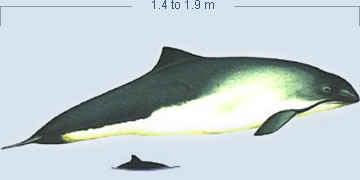
Description:
Small in size with a rounded head (no beak) and triangular dorsal fin. Dark grey/black colour with a lighter underside
Size: 1.4 to 1.9 m
Habitat: Seen year-round in coastal areas
Group size: Usually 2 to 5
Behaviour: Seldom bow-rides and surfaces with a slow, rolling motion
Similar species: None
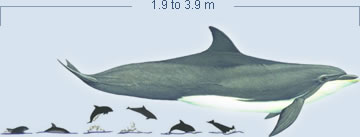
Description:
Large dolphin with prominent dorsal fin and distinct beak. Grey in colour with a paler underside
Size: 1.9 to 3.9 m
Habitat: Seen year-round in coastal areas, often inshore and close to land
Group size: Typically 3 to 10 but can be up to 30
Behaviour: Highly active and often bow-rides
Similar species: Could be confused with Risso's dolphin, but Risso's have no beak and often have white markings on their bodies
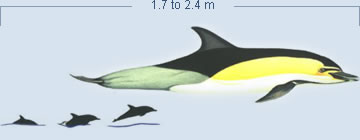
Description:
Slender dolphin with a long narrow beak and a distinctive hour-glass pattern on its side
Size: 1.7 to 2.4 m
Habitat: Summer visitor to coastal and offshore waters
Group size: Usually 30 to 50
Behaviour: Keen bow-riders and often very active at the surface
Similar species: Coud be confused with Atlantic white-sided dolphin
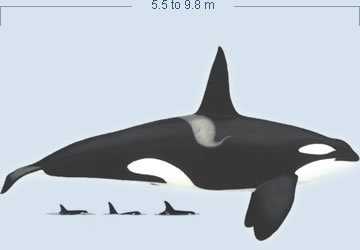
Description:
Distinctive black and white colouring with a grey saddle patch behind each eye. Males have very tall dorsal fins (up to 2m high); females and immature animals have smaller, curved fins. Flippers are rounded and paddle-shaped
Size: 5.5 to 9.8 m
Habitat: May be seen almost anywhere in the Hebrides but sightings are rare
Group size: 2 to 10
Behaviour: Although they rarely bow-ride they will approach boats, often breach, spyhop or slap their flippers/tail on the water surface
Similar species: Female/juvenile killer whales can be confused with white-beaked and Risso's dolphins
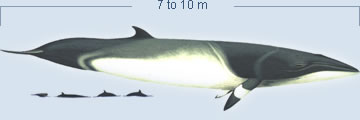
Description:
This is a slender and streamlined whale with a narrow pointed head and a small, strongly curved dorsal fin. It is dark grey/black with a white underside and a distinctive white band on each flipper
Size: 7 to 10 m
Habitat: Summer visitor to coastal waters
Group size: Tend to be solitary but can be seen feeding in groups of up to 10
Behaviour: Before a dive, minke whales arch their back but do not raise the tail fluke out of the water and so it is most typically their back and dorsal fin that are seen. Often associated with Manx shearwaters feeding at the surface
Similar species: Minke whales are smaller than other baleen whales seen in the Hebrides
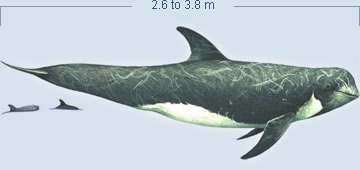
Description:
Silver-grey/cream or white in colour, due to large number of scars and scratches on their body. They tend to lighten in colour with age as scarring increases. Have a rounded head (no beak) and tall dorsal fin
Size: 2.6 to 3.8 m
Habitat: Prefers deep water but may be seen in coastal areas
Group size: Usually small groups but can be up to 50
Behaviour: Seldom bow-ride but may swim alongside boat. Young animals often breach
Similar species: Can be confused with bottlenose dolphins, female/juvenile killer whales and white-beaked dolphins
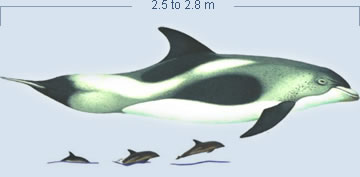
Description:
Have a robust body with a short beak and prominent dorsal fin. Beak colour varies from white to brown/grey. Body is black in colour with white patches along their sides and a pale area behind the dorsal fin and on their tail stock
Size: 2.5 to 2.8 m
Habitat: Typically seen in open water and in the northern Hebrides
Group size: Usually small groups but larger groups are seen
Behaviour: May bow-ride and are fast powerful swimmers
Similar species: Can be confused with female/juvenile killer whales and Risso's dolphin
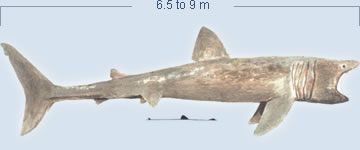
Description:
Has a conical snout and large mouth, which contains bristle-like gill rakers for filter-feeding. Body is grey in colour with a distinctive, large, triangular dorsal fin
Size: 6.5 to 9 m
Habitat: Summer visitors to coastal areas
Group size: Often solitary but can be seen in groups of 1 to 100
Behaviour: Most easily recognised by the distinctive dorsal fin and tail tip, which are typically above the water surface as it swims in a slow sweeping motion while feeding
Similar species: None





